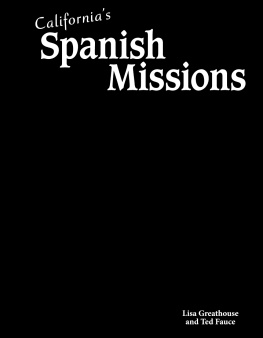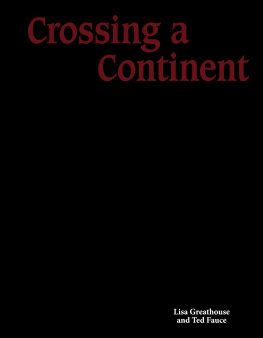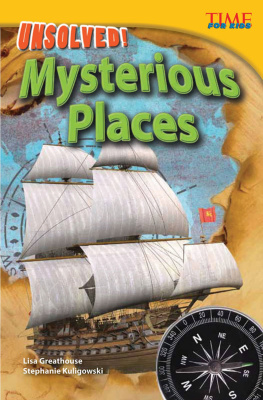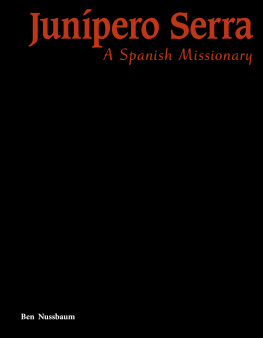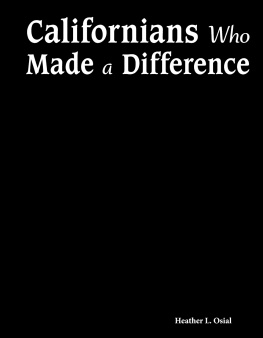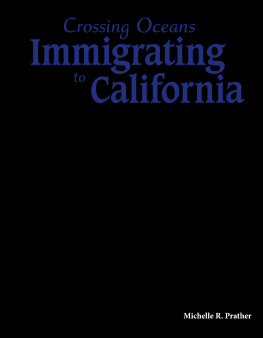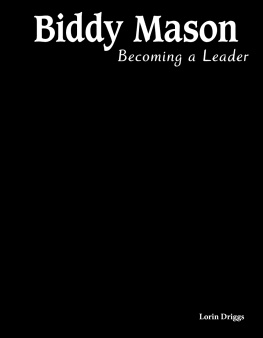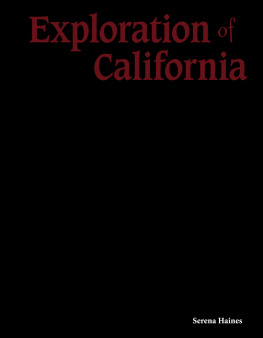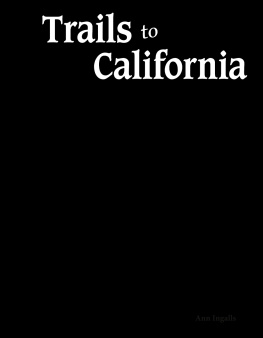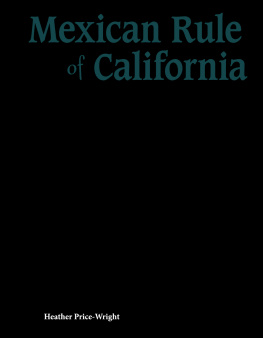Lisa Greathouse - Californias Spanish Missions
Here you can read online Lisa Greathouse - Californias Spanish Missions full text of the book (entire story) in english for free. Download pdf and epub, get meaning, cover and reviews about this ebook. year: 2018, publisher: Triangle Interactive, LLC, genre: Politics. Description of the work, (preface) as well as reviews are available. Best literature library LitArk.com created for fans of good reading and offers a wide selection of genres:
Romance novel
Science fiction
Adventure
Detective
Science
History
Home and family
Prose
Art
Politics
Computer
Non-fiction
Religion
Business
Children
Humor
Choose a favorite category and find really read worthwhile books. Enjoy immersion in the world of imagination, feel the emotions of the characters or learn something new for yourself, make an fascinating discovery.
- Book:Californias Spanish Missions
- Author:
- Publisher:Triangle Interactive, LLC
- Genre:
- Year:2018
- Rating:3 / 5
- Favourites:Add to favourites
- Your mark:
- 60
- 1
- 2
- 3
- 4
- 5
Californias Spanish Missions: summary, description and annotation
We offer to read an annotation, description, summary or preface (depends on what the author of the book "Californias Spanish Missions" wrote himself). If you haven't found the necessary information about the book — write in the comments, we will try to find it.
Californias Spanish Missions — read online for free the complete book (whole text) full work
Below is the text of the book, divided by pages. System saving the place of the last page read, allows you to conveniently read the book "Californias Spanish Missions" online for free, without having to search again every time where you left off. Put a bookmark, and you can go to the page where you finished reading at any time.
Font size:
Interval:
Bookmark:
0covercover.xhtmlCalifornia's Spanish Missions Lisa Greathouse and Ted Faucecover1page0001page0001.xhtmlRead and Respond 1. Identify at least three people who helped establish the missions, and explain what each person did. 2. Explain the reasons the missions were built and how their locations were determined. 3. Compare and contrast a rancho, a presidio, and a pueblo. 4. Describe how the missions affected the native populations in California. 5. What do you think are the legacies of the Spanish missions? 6. Write a newspaper article about one of the American Indian rebellions. Include witnesses from both sides.22page0002page0002.xhtmlCalifornia's SpanishMissions Missions33page0003page0003.xhtml44page0004page0004.xhtmlTable of Contents A New World 4 The Sacred Mission 8 Mission Buildings 14 Mission Life : Changes and Conflicts 20 Legacy of the Missions 26 Track It 28 Glossary 30 Index 31 Your Turn 32 kitchen at Mission Santa Barbara55page0005page0005.xhtmlA New World In 1492, Christopher Columbus set sail for Asia. He was searching for a quicker route to the spices, silk, and art that could be found there. What he found was a new world. It became known as the Americas. Soon, explorers claimed huge pieces of this new land. They wanted to start colonies. Spain, Portugal, England, and France fought for control of the New World. They wanted to find gold, silver, and jewels. These resources were used to expand power and influence. But riches and trade were not the only reasons to explore the new land. Sharing America People in Europe wanted to spread their religions to the world. Spain felt that religion could improve the lives of the native people living in the Americas. Spanish leaders also saw this as a way to protect and grow its power in the New World. California's Name When Spanish explorers claimed the new land, it reminded them of a place in a book. The book was written in 1510. It was about a scenic island ruled by Queen Calafia. The name California comes from this myth. This 1650 map shows California as an island.66page0006page0006.xhtmlWorld Map from 1772 British Possessions Red French Blue Portuguese Yellow Spanish Green Dutch Orange77page0007page0007.xhtmlWhen settlers came to the New World they saw millions of people living there. These people were American Indians. They had lived on this land for thousands of years. Their ancestors had come to North America in the last Ice Age. At that time, Russia and Alaska were joined by a land bridge. Once they crossed the land bridge, they spread through the continent and formed tribes. California Indians lived in what is now California and northern Mexico. These tribes lived off the land. Their homes, clothes, and even their food were based on where they lived. Tribes near the coast mainly ate sea creatures, such as otters and seals. Many tribes in the valleys lived off birds, such as quail. These different ways of life built a huge trade network. Food was one of the most common things for tribes to trade. Each tribe traded items from their area for things they needed from tribes in other areas. When settlers arrived, they found tribes that were independent but interrelated. American Indians in Yosemite Valley88page0008page0008.xhtml An Appetite for Acorns Since acorns were plentiful in the state, they were a large part of the California Indians' diet. Preparing the nuts was a long process. First, acorns were dried for a year. Then, grinding tools were used to make them into meal. This is similar to flour. After the meal was made, some tribes used it to make biscuits or bread. Others boiled the meal and ate the mush, which is thicker than a soup. Strong Homes California Indians used different materials to build their houses. Tribes living close to the coast built grass mat houses. If tribes lived in an area with lots of trees, they built their houses out of cedar bark (shown here).99page0009page0009.xhtml The Franciscan Order An order is a name used for a group of religious men. Many priests who came to America to build missions belonged to the Spanish Franciscan Order. These priests agreed to live simple lives and didn't own property. This allowed them to focus on converting the native people. The Sacred Mission Spanish leaders knew that missions helped settle and protect their land. They had built missions in Florida and Texas years before. In California, they planned to do the same thing. Men who were loyal to Spain were needed. These men had to be willing to die for their faith. The priests knew it was their duty to convert the American Indians in California. Soldiers had to secure the land for Spain. This became known as the Sacred Expedition.1010page0010page0010.xhtmlThe journey began in 1769. A group of men went to San Diego on horseback and by foot. There were soldiers and priests in the group. Gaspar de Portol (deh por-toh-LAH) led the soldiers. Father Junpero (hoo-NEE-peh-roh) Serra led the priests. One man kept a journal of the trip and the land. His name was Father Juan Cresp (crehs-PEE). His journal provides a lot of information. Keeping Records Cresp wrote about mountains, valleys, trees, and animals. He noted how American Indians lived. His notes came in handy for the men who built the missions. The Spanish explored all the way to the San Francisco Bay.1111page0011page0011.xhtmlJunpero Serra Father Serra is the most well-known priest of the Mission Era. He wanted to be more than just a priest. His goal was to bring his religion to the American Indians. After he started the first mission in San Diego, he helped build eight more. Serra was very strict. He converted thousands of American Indians. He forced them to adopt a new way of life. Soldiers helped enforce his stern rules. Near the end of his life, Serra had plans for more missions. After he died, his followers helped finish what he had planned. The last mission in San Francisco was opened in 1823. In all, it took 54 years to build 21 missions. Junpero Serra Saint Serra In 1987, Pope John Paul II a sked that Serra be made a saint. This was to honor his work. He brought Chri stianity to the American Indians. It to ok almost 30 years for Serra to become a saint. He was canonized in 2015 by Pope Francis.1212page0012page0012.xhtml Final Resting Place Serra was 56 years old when he built the first Spanish mission. He died in 1784 at the age of 70 in his room at Mission Carmel. He is buried beneath the church there. Mission Carmel1313page0013page0013.xhtmlGaspar de Portol The Royal Road Portol's route north through California became known as El Camino Real. This means "The King's Road. " Today, Highway 101 (shown here) follows much of this same route.1414page0014page0014.xhtmlGaspar de Portol Many people helped build the missions and keep them safe. Portol was one of those men. He was a Spanish army captain. In 1767, he sailed to the New World. He joined Father Serra on the Sacred Expedition. He helped build the presidios. These buildings protected the missions. The trip was hard. Along the way, the Spanish experienced earthquakes and often ran out of food. When the food supply was low, the Spanish traded with the American Indians. The soldiers traded beads and their clothes. In return, they received fish and corn. Portol trekked north to San Francisco. He went as far as where the Golden Gate Bridge now stands. He helped Spain keep California. At the time, Spanish leaders feared that Russian fur trappers would claim this land. Portol set the groundwork for missions to be founded. The success of his journey relied on the help of American Indians. Sadly, these same missions would change the native peoples' lives and culture. Inner Thoughts During his trip, Portol began writing a journal (shown here). In it, he wrote about the tribes he met. In late July 1769, he wrote about an "earthquake of such violence. " That entry is the first report of an earthquake in California.1515page0015page0015.xhtmlAmerican Indian village Mission Buildings Each mission had many buildings surrounded by land that had been cleared of trees. Many missions were built on hills. All of them had churches and buildings where the priests and soldiers lived. Each had a kitchen, a dining hall, classrooms, and workshops. There were also large pieces of land to grow crops, as well as corrals and coops for animals.1616page0016page0016.xhtmlTo be safe, some missions were built inside presidios surrounded by strong walls. Other missions were on land called ranchos. The ranchos were used for raising cattle and sheep. Some missions became the center of villages known as pueblos. This is where many people lived together. In later years, many pueblos would become larger cities. laundry area gardens church Unique Architecture All missions are noted for their use of domes, vaults, and arches. The most distinctive part of each mission church is the belfry. The campanile (kam-puh-NEE-lee) style belfry was a large tower that held one or more bells.1717page0017page0017.xhtmlDifferences Among Missions Missions were not all the same. One of the reasons for this is California's geography. The state is long and has many miles of land near the ocean. Because of the state's size, shape, and location, it has varied climates. Rain and snow fall mostly on the mountains. This process makes the land behind them dry. These areas form deserts. Mountains and deserts were not good places to build missions. Most missions were built along the coast, which has a mild climate. Life in a mild climate is easier. It's great for raising crops and animals. Each mission relied on nearby natural resources. The missionaries learned how to use those resources from the California Indians. The mission system settled and developed the land for Spain. Inland Mission The mission that was built farthest from the coast was Soledad Mission. It is 30 miles (48 kilometers) inland from the coast.1818page0018page0018.xhtmlMission to Mission The builders of the missions wanted to keep in touch. They built each mission about one day's horseback ride apart. Landforms, fresh water sources, and other factors also determined where the missions were built. Most missions were about 30 miles (48 kilometers) apart. Key mission presidio pueblo1919page0019page0019.xhtmlSan Luis Obispo Mission San Luis Obispo was very different from the other missions. It was founded in 1772 by Father Serra. It was built in an area that had a lot of grizzly bears. The mission relied on the meat that the bears could provide. Food was running low at other missions. There was a large hunt. Many bears were killed, and the meat was shared. Later, people began farming wheat and corn to provide food. Weather Matters Missions in the southern part of California had much different weather from those in the north. The south was sunny but dry. Citrus fruits grew well in the south. Mission Santa Clara, 18492020page0020page0020.xhtmlSanta Clara Mission Santa Clara was one of the nine missions built by Father Serra. It was built in 1777. Flooding from the local river made the soil wet, similar to a marsh. Over the next 45 years, this mission had to be moved more than once. The mission was moved to its final place in 1822. The soil in the area was very good for farming. Santa Clara had one of the best wheat crops of all the missions. Like many missions in the north, people at Santa Clara grew grapes and made wine. From Mission to College Santa Clara University opened in 1851. It was built on the site of the old mission. It is the oldest college in the state. Today, students can see parts of the old mission's buildings around campus.2121page0021page0021.xhtmlFather Serra having Mass New Converts Indians who converted to Christianity and lived on the missions were called neophytes. Neophyte is a Greek word. It means "new convert. " The term was used in many places around the world for new converts. Mission Life : Changes and Conflicts People lived in the area that is now California for thousands of years. Pieces of clay pots and weapons from these times have been found. Before the missions were built, American Indians followed their own traditions. More than 50 tribes lived there. They spoke over 100 different languages. They had thriving villages and knew how to live off the land.2222page0022page0022.xhtmlFor the American Indians, mission life was a change from their previous lives. The Spanish forced them to live and work at the missions. Their children went to schools there, too. They learned a new language and had to convert to a new religion. Many native people fought against these changes to their way of life. American Indians hunt grizzly bears. Before Farms Before the missions, the native people lived off the land. They hunted and gathered only what they needed for food, clothing, and shelter. They never killed animals or fish unless they could use them. American Indians had great respect for land and nature.2323page0023page0023.xhtmlsoldiers, priests, and California Indians at one of the missions Changes Mission lands were split into sections. Some of the land was used for growing crops. Other parts were used for raising animals. All the land needed to be cleared of rocks, trees, and weeds to make room for crops and animals. American Indians did this hard work at the missions all day long. Many native people tried to flee. One in ten ran away from the missions. Many more tried to leave but were stopped. If they were caught, they were forced to return to the missions.2424page0024page0024.xhtmlLeaving was risky but so was staying. When Europeans came to the New World, they brought illnesses with them. The native people did not have immunities. In 1806, measles spread throughout the missions. It killed more than 1, 000 American Indians at the Santa Barbara mission alone. Most of those who died were children. During this time, 60, 000 American Indians would die at the missions. Many of those deaths were caused by disease. Culture Survives Today, California is home to the largest number of native people in the country. There are over 100 tribes in the state. These tribes have played key roles in saving forests and animals in the state. They have also worked to keep their culture alive.2525page0025page0025.xhtmlConflicts Not all American Indians tried to flee from the missions. Some tried to resist their new way of life. There were many revolts. In 1775, nearly 1, 000 native people attacked the San Diego mission. They burned it to the ground. During the night, a priest was killed. Spanish soldiers caught and punished the native people who led the attack. But that revolt was just the first of many. Attacks went on for years up and down the state. Most of them did not improve things. In fact, many times, they made life worse for the native people. Spanish soldiers wanted to keep American Indians from revolting. They used many methods to do this. One of the most common ways was to publicly punish the native people who took part in the revolts. This photograph shows the remains of Mission San Diego after a fire. Tile Rooftops To protect the missions from flaming arrow attacks, the rooftops were changed to tile. The tiles were made from clay and dried in the sun. Then, they were baked in kilns. Today, many modern buildings use tile rooftops like the missions.2626page0026page0026.xhtml Fighting Back Two American Indians led the attack on the San Diego mission. They were tired of not having control over their lives. The men went to nearby villages. They told their stories to the tribes there. Those tribes agreed to help them revolt. By the time of the attack, the two men had gathered over 800 supporters. American Indians rebel against a Spanish priest.2727page0027page0027.xhtmlLegacy of the Missions The mission system lasted almost 70 years. It changed when Mexico took control of the area in 1821. Mexican leaders began a plan called secularization. This meant that the church would no longer have power or own the land. The land was to go back to the California Indians. But this did not happen. Instead, the new government gave it or sold it to non-natives. Missions Today Many of the mission churches are still active. Weddings and funerals are held there. Masses are still performed at some of the missions. Mission San Juan Capistrano2828page0028page0028.xhtmlGifts from the Missions Even though there were some bad outcomes from the missions, there were some good as well. The names of many cities come from the missions. The first crops grown at the missions helped improve farming methods in the state. Stucco and tiled rooftops on houses were first used on the missions. The freeways and highways were once mission trails. The missions helped define the state of California. bell marker for El Camino Real Road Trip The California missions are host to millions of tourists each year. Luckily, there is an easy way to see them all. Just take the California Missions Trail! This 600-mile (950-kilometer) trek spans most of the state. Buckle up and get comfortable!2929page0029page0029.xhtmlTrack It! The Mission Era lasted almost 70 years. By identifying and describing the era's major events, other people can learn about its importance to California and the American Indians. Create a time line that shows the people, places, and events of this time period. Be sure to include names of people and places where possible. Mission Santa Barbara3030page0030page0030.xhtml3131page0031page0031.xhtmlGlossary belfry part of a church where the bells are; bell tower canonized officially declared a saint by the Roman Catholic Church climates the usual weather conditions of places colonies areas ruled by a country or countries far away convert change from one religion or belief to another corrals fenced-in areas to keep animals founded built or started immunities the body's abilities to fight off infections from diseases interrelated connected to one another kilns ovens used for hardening, burning, or drying things, such as pottery marsh a soft, wet area of land that has many plants missionaries people sent by a church to convert others missions places or buildings where religious work is done presidios walled forts used to protect property ranchos Spanish word for ranches ; large pieces of land revolts attempts to end someone's authority secularization the act of separating something from a religious connection stucco a material that is used to cover the outside walls of houses and buildings traditions ways of thinking or doing something that have been done by a particular group for a long time3232page0032page0032.xhtmlIndex American Indians, Asia, Calafia, California Indians, California Missions Trail, Carmel, Christianity, climates, colonies, Columbus, Christopher, Cresp, Juan, de Portol, Gaspar, El Camino Real, England, Florida, France, Golden Gate Bridge, hunted / gathered, Mexico, native people, Pope John Paul II, Portugal, presidios, pueblos, ranchos, Sacred Expedition, San Diego, San Francisco, San Juan Capistrano, San Luis Obispo, Santa Barbara, Santa Clara, Santa Clara University, Serra, Junpero, Soledad, Spain, Texas, Mission San Diego3333page0033page0033.xhtmlYour Turn! Different Perspectives During the Sacred Expedition, Father Cresp wrote details about the geography of California. He also noted details about the California Indians and how they lived. The California Indian perspective was not recorded very often. Imagine you are a California Indian. You live during the Sacred Expedition in the San Francisco Bay area. Look at the Spanish soldiers and missionaries in the painting. As a California Indian, what do you first think and feel? What are you curious about? Write a detailed journal entry about that first sighting.3434page0034page0034.xhtmlRead and Respond 1. Identify at least three people who helped establish the missions, and explain what each person did. 2. Explain the reasons the missions were built and how their locations were determined. 3. Compare and contrast a rancho, a presidio, and a pueblo. 4. Describe how the missions affected the native populations in California. 5. What do you think are the legacies of the Spanish missions? 6. Write a newspaper article about one of the American Indian rebellions. Include witnesses from both sides.35
Next pageFont size:
Interval:
Bookmark:
Similar books «Californias Spanish Missions»
Look at similar books to Californias Spanish Missions. We have selected literature similar in name and meaning in the hope of providing readers with more options to find new, interesting, not yet read works.
Discussion, reviews of the book Californias Spanish Missions and just readers' own opinions. Leave your comments, write what you think about the work, its meaning or the main characters. Specify what exactly you liked and what you didn't like, and why you think so.

